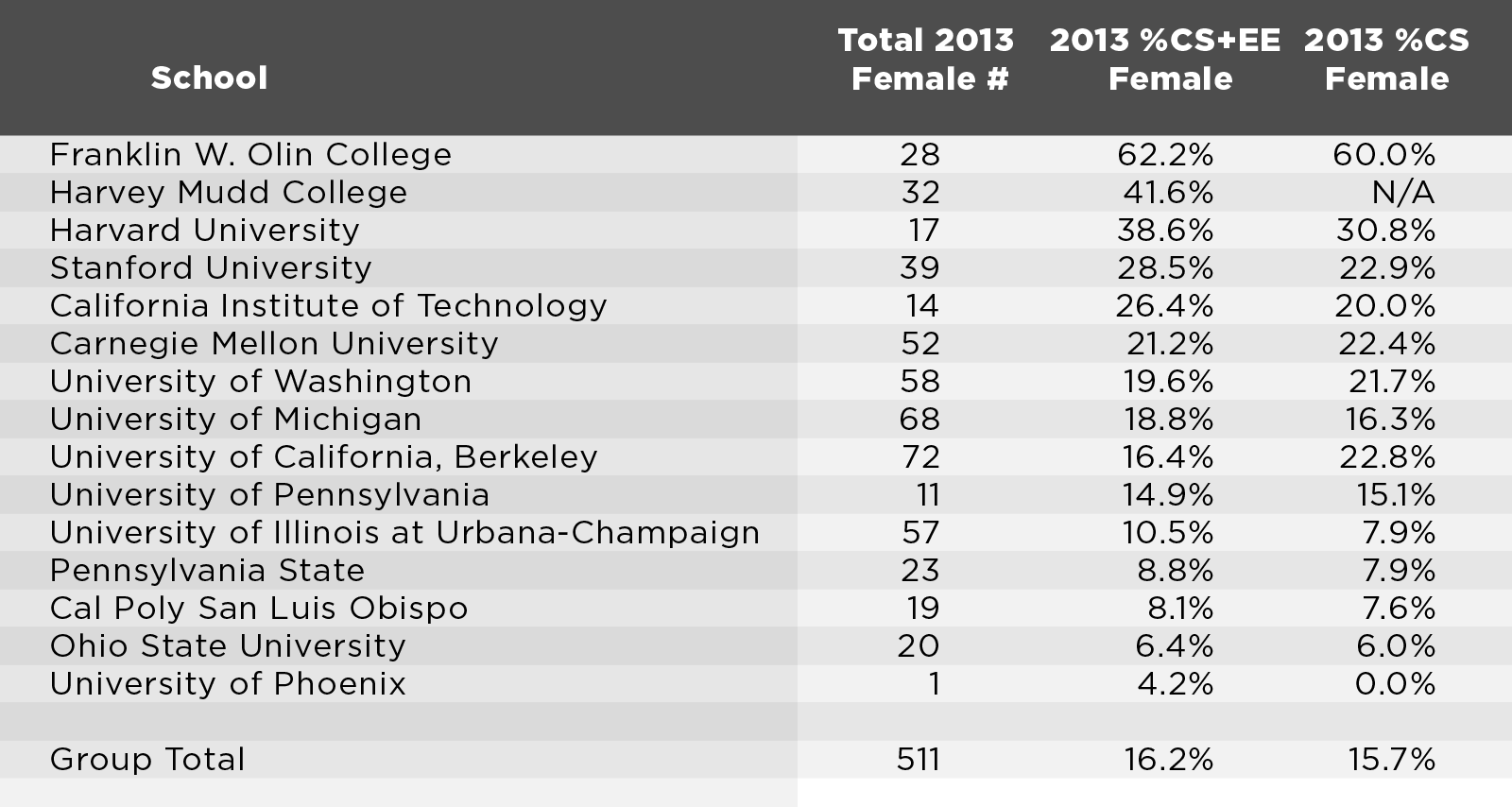“I’m worried about my company becoming too dude-ish,” the founder said. “How do I hire more women engineers?” I gladly took that call. A leader’s job is to build the team with as few blind spots as possible (“diverse by construction”), then guide them to their potential.
The founder who called me worries that in the competitive war for talent his startup might be ignoring, or worse yet, repelling a meaningful set of candidates.
Many studies (here and here) show diverse teams make better decisions. This post is meant to give practical tips on how to change the ratio in your company, specifically in technical teams.
Find The Candidates
College recruiting is a good place to start. The basic statistic widely quoted is 18 percent of computer science (CS) graduates are women, but that masks a lot of insight. Many colleges have a much higher percentage women CS graduates, and some are far worse. Contrary to popular wisdom, the more selective schools have dramatically higher percentages of women and higher raw numbers of women than average; some of the large state universities that make the highest raw number of men STEM (Science, Technology, Engineering and Math) graduates also graduate the fewest and lowest percentages of women.
I analyzed CS and Electrical Engineering (EE) degrees together, as some schools don’t distinguish between the two (i.e., Harvey Mudd). This table is merely illustrative of the diversity of raw numbers and ratios of women with CS skills in various schools.
The most frightening aspect of this data is that even at colleges with a high percentage of women CS grads, the numbers are still small. This group of colleges, known either to have high percentages of women (Harvey Mudd), large CS programs (Stanford) or to graduate the largest quantity of STEM students (Ohio State and Penn State), overall makes a tiny number of women CS grads: 511 total women in 2013. If Google hired ALL these women, it would increase their female percentage by 1.5 percentage points, leaving the whole rest of the technology industry bereft of female new-college-grad hires.
Non-traditional educational settings are becoming valid recruiting sources for female software developers.
The good news is that many colleges have much higher percentages and numbers of women who take enough CS classes to qualify to be a software developer without having a CS or EE degree. However, data by classes taken is difficult to come by. These women engineering candidates may have “wet majors” such as biology. Even Computational Biology students are not included in schools’ ASEE CS data. Women also have majored in math, physics, economics or liberal arts and have computer science experience.
As an example, UC Berkeley enrolls more than 1,300 students in CS61A, and 1,100 in CS61B; only about half of those students are CS majors, yet the combination of the two generally qualifies a student to work in industry as a developer, so Cal is producing another roughly 500 people per year who can work as developers, or roughly double the totals from above. But recruiters have to search for students from many majors who also have taken CS61A/B. Simple filters on LinkedIn or in university resume databases won’t uncover these women candidates.
Note that the widely cited Berkeley “Intro to Programming” class with more than 50 percent women is a terminal survey class (CS10) that does not count toward a CS degree nor prepare students to work as developers on its own. Students who enjoy CS10 still must go on to take CS61A/B to become qualified coders.
Non-traditional educational settings are becoming valid recruiting sources for female software developers. Many community colleges in California also teach the equivalent of Cal’s CS61A/B, so recruiting from them is possible. Again, recruiters need to look for courses in Data Structures, Algorithms and Programming Methods. In the Bay Area, Foothill College, College of San Mateo and De Anza College all teach numerous relevant courses.
Intensive coding “bootcamps” have quickly evolved to fill entry-level software engineering jobs. These are often for-profit entities that teach development fundamentals and practical skills, usually full-time for 10 to 12 weeks. General Assembly is the largest dev bootcamp nationwide, but serves mostly men.
Industry is another place to source women developers. Big companies have diversity programs with multi-year objectives. None of those succeed without a senior sponsor and, sadly, many initiatives to #changetheratio are failing due to lack of focus. Disenfranchised females in those big companies are prime recruiting targets for organizations that are committed to increasing diversity. You can find women engineers in organizations such as She++, NCWIT, Women 2.0, WITI and GirlGeeks.
More than just a source for women disgruntled by lack of diversity, big companies do a great job training people in management, so startups can hire experienced team leads and executives from larger companies while filling in rank and file engineering spots with college and bootcamp new hires. As Diane Krakora, CEO of PartnerPath said, “as a small startup, we have a hard time competing with bigger companies for industry hires. We have a handful of senior architects, then ‘grow our own’ developers by recruiting from coding schools and bootcamps. Those devs have the grit to get work done.”
Assess Your Readiness To #changetheratio
First, grab the low-hanging fruit of getting ready to hire women. Signal that your company has (or at least has thought about having) women by instituting policies for pregnancy and family leave and sexual harassment and discrimination. The Society of Human Resource Management has numerous templates and samples, and some data on startup policies is covered here. If you don’t have these policies in place, a candidate may conclude that your company has never conceived of needing them, and therefore you’re not serious about hiring women.
This is the technology industry; start with a quantitative analysis.
Additional simple fixes that make your company look receptive to women include having women represented in company images. Check your website, jobs pages, LinkedIn and Glassdoor profiles. Then check your customer case studies and other marketing materials. Do they imply that everyone important in your universe is male? Can a female candidate look at your outside walls and see herself being successful inside?
This is the technology industry; start with a quantitative analysis. Evaluate your situation and make a plan. Quantify your ratios: candidates, offers, new hires, retention rates and promotions. High-growth startups can dramatically change ratios without extraordinary changes in pipeline because the number of new hires is high relative to existing employees.
A company with 75 employees and 20 percent women (15 women) can change to 25 percent women in one year in which it doubles headcount and adds 23 women of 75 employees hired (assuming no turnover). Conversely, large companies need to post big numbers to move their ratios in fractions. For example, in a year of intense focus, 2014 to 2015, Facebook grew its percentage of women in technical staff from 15 percent to 16 percent. That year, their overall employment grew by more than 1,000 people, or roughly 25 percent.
Deeper in your engineering department, scrutinize treatment across pay, promotion and praise. Here’s an example of pay equity and performance review bias. Are the existing women’s code forks pulled as often as men’s? Do women fix and regress bugs, or implement new features? This is critical advice: Have quantitative (e.g., SMART), non-gameable criteria for evaluating performance. Making it clear that results trump “bro” relationships will radically change team dynamics for the better.
Examine Your Job Listings’ Language
If you ask for “rock stars” and “super heroes” who like to “hang out, play ping pong and drink beer,” will you get men and women candidates to apply? Unlikely. If you want female applicants, craft job descriptions that are gender neutral.
Keep the list of required skills short. Women tend to believe they have to check every box before being qualified, so long lists decrease the chance that women will apply.
Maximize Your Pipeline
I surveyed experts in how to build a pool of talented women job candidates. Here are my favorite hacks:
- Increase your referral bonus to employees/friends for underrepresented candidates.
- Task your interns with meeting other interns and making lists. Host intern events. Be a hub for women interns.
- Get your high-value female candidates/interns audiences with “important women” to get them career exposure.
- Host annual bootcamps/hack days for women engineering students.
- Use alumni access to campus career centers to get resume books of seniors. In addition to traditional CS majors, look for women graduating with technical interdisciplinary concentrations — you will find a lot of coding experience in many other engineering and science majors.
- Host a coding conference about a specific vertical that interests women.
Craft A Process That Favors Diversity
Start with the pile of resumes. Right at the top is a gender signal, the candidate’s name. Unfortunately, that signal carries a lot of weight, so screen resumes and pass them to hiring managers on a name/gender-blinded basis.
The set-up and décor of a room can signal whether a woman belongs or not. You don’t have to interview candidates in a room with daisies and doilies, but an office filled with gamer gear and Star Wars paraphernalia won’t be broadly appealing. Worse yet, a more masculine environment can undermine talented women’s interview performance. Find neutral ground.
Making it clear that results trump “bro” relationships will radically change team dynamics for the better.
Silicon Valley prizes meritocracies, yet many recruiting processes yield “mirrortocracies,” a term attributed to Mitch Kapor. Here are great articles with lots of interview tips for recruiting diverse, talented engineers.
Consider replacing your whiteboard exercise, which is stressful for many women, with a blinded online coding challenge. You will have a consistent dataset across candidates.
Recruiting with women will enhance your chance to hire more. If you don’t have women hiring managers or even team members, bring some female product managers or QA engineers into the process.
Present the company professionally. Many women have complained to me of basic hygiene issues with developers who interviewed them. Worse yet, candidates are sometimes dinged and asked for a date in the same conversation.
Train your interviewers how to screen for talent and how to comply with EEOC rules. Show that diverse people can succeed inside your company. Emphasize the intrinsic value of your product/work.
The First One Is The Hardest
Start recruiting women early; as a company grows with few women, recruiting them will become harder as monoculture becomes entrenched, and women perceive no “ambient sense of belonging.”
You don’t have to interview candidates in a room with daisies and doilies, but an office filled with gamer gear and Star Wars paraphernalia won’t be broadly appealing.
You can build your pipeline of female talent by starting early: Target college or high school interns. Or, start at the top and hire a very senior woman. If you don’t have a senior female tech executive, hire a strong female product executive, so the non-dev counterpart to engineering is female; this helps set a female-by-proxy presence in the department. Send good vibes in visible ways to external women who are prominent technical experts (e.g., Lila Tretikov, Elaine Wherry). Support them on social media and GitHub. Make diverse hiring a recursive function: Women hire more women.
To succeed, you need to care. And that means having the most senior executives and founders care, else all the team will model the leadership’s lack of valuing diversity. Most senior executives are not trained properly on how to recruit/promote/train/retain talent in general, let alone a specific demographic. Consider having an MBO bonus on diversity to encourage those executives at least to become educated on the topic. It starts to drive awareness on a personal level. It’s far more impactful to hold executives and teams accountable for diversity when the easy path is merely to sign up for some hackathons. And impact is what we crave in Silicon Valley.

